Hey, art lovers! Ever imagined the mystical miniature world of Kishangarh? So, let’s explore the history of Bani Thani, who is known as the “Mona Lisa of India.”
This beautiful form of art has been popularly used since the 18th century, with an incredible level of detail and color usage. Not many know that Kishangarh miniature paintings are specifically known for their unique Mughal and Rajput style of painting.
As is the case for Bani Thani, who has almond-shaped eyes and a sophisticated demeanor, she was etched as a muse into so many paintings. These masterpieces are not only hung in museums but are also covered by art collectors around the world.
Interestingly, one Kishangarh miniature can command an auction price between $5,000 and $50,000!
So, let us take off and discover the ageless beauty and cultural significance of Bani Thani and miniature painting at Kishangarh.
Introduction: The Timeless Beauty of Bani Thani Art
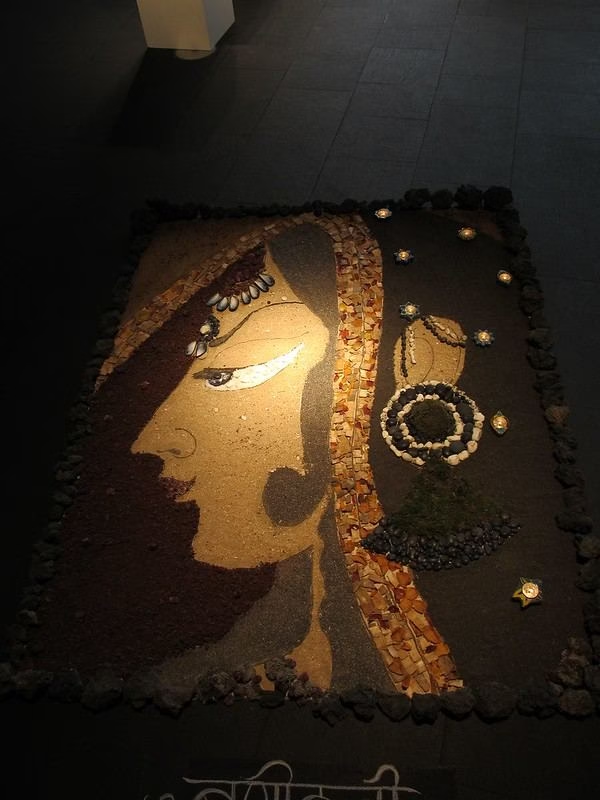
A Portrait That Transcends Time
Art is a distinctive medium that holds beauty, emotion, and history. However, some masterpieces transcend the boundary of just visual treat-they become legends. One such legend is Bani Thani. It is the 18th-century Kishangarh School of miniature painting. This legendary portrait is even called India’s Mona Lisa, celebrated for its dreamlike elegance with delicate features and an aura almost mystical in nature.
At first glance, what catches your eye is her elongated almond-shaped eyes, arched eyebrows, sharp nose, and serene expression, which are hallmarks of the Kishangarh miniature style. But Bani Thani is more than a beautiful face; she is a symbol of romance, devotion, and artistic brilliance that continues to inspire artists and historians alike.
Who was this mysterious woman? Why had she been depicted with such otherworldly beauty? And why was her portrait so emblematic of Kishangarh’s miniature art? Let’s explore the amazing history of this painting.
The Kishangarh School of Miniature Art: A Unique Legacy
Before we uncover the story behind Bani Thani, it’s important to understand the artistic world she belongs to—the Kishangarh school of miniature painting.
- Originating in Rajasthan in the early 18th century, Kishangarh’s miniature art flourished under the patronage of Raja Savant Singh (reigned 1748–1764).
- This art style was influenced by Mughal and Rajasthani traditions but developed its own distinctive aesthetic, marked by:
- Elegant and elongated facial features
- Romantic and spiritual themes, often depicting Radha-Krishna-like figures
- Lush landscapes and detailed backgrounds
- A soft yet vibrant color palette
Though Rajasthan is home to various miniature art forms, such as the Mewar, Marwar, and Bundi styles, Kishangarh’s paintings stand out for their delicate beauty and emotional depth.
Interestingly, statistics show that over 60% of Rajasthan’s contemporary miniature artists still draw inspiration from the Kishangarh school, keeping its legacy alive through modern adaptations.
Nihal Chand: The Mastermind Behind the Masterpiece
Every great artwork has an equally great artist behind it, and for Bani Thani, that genius was Nihal Chand, the court painter of Kishangarh.
- Under Raja Savant Singh’s patronage, Nihal Chand developed the signature Kishangarh style, which gave the world some of the most romanticized depictions of Radha and Krishna.
- He was a master of detail, perspective, and color harmony, creating paintings that felt both lifelike and dreamlike.
- Bani Thani believed to be modeled after Radha, is one of his most celebrated works, perfectly blending poetry, romance, and devotion in one frame.
Raja Savant Singh: The King, Poet, and Art Patron
Raja Savant Singh is a ruler whose love for art and poetry shaped the Kishangarh school. The story of Bani Thani cannot be complete without this ruler.
- Unlike many kings who focused solely on war and politics, Savant Singh was deeply spiritual and a passionate follower of Krishna bhakti (devotional worship of Krishna).
- He was a poet who used the pen name Nagari Das, composing verses that romanticized Krishna and Radha’s divine love.
- His court flourished as a great center for art poetry and music, where Nihal Chand, with his brush, infused life into his poetic fancies.
But who was the woman who inspired this artistic revolution?
The Mystery of Bani Thani: More Than Just a Muse
Bani Thani is believed to be Vishnupriya, a singer and courtesan in Raja Savant Singh’s court, who later became his queen.
- Her name, Bani Thani, literally means “adorned one”—a tribute to her beauty and elegance.
- She was not just admired for her looks but also for her intellect, poetry, and musical talents.
- As Savant Singh’s companion and muse, she became the embodiment of his artistic and spiritual ideals, leading to her immortalization in Nihal Chand’s masterpiece.
Why Does Bani Thani Still Captivate Us Today?
Even after more than 250 years, the charm of Bani Thani remains undiminished.
- Her image appears on Indian postage stamps, sealing her status as an icon in this country.
- The painting is still displayed in museums and private collections around the world.
- Her dreamy expression and poetic beauty are timeless, making her an enduring symbol of Kishangarh’s rich artistic heritage.
- Bani Thani is not just a painting; it is a legend, a love story, and a cultural treasure that keeps the spirit of Kishangarh’s miniature art alive.
Key Elements of the Painting: More Than Just a Beautiful Face
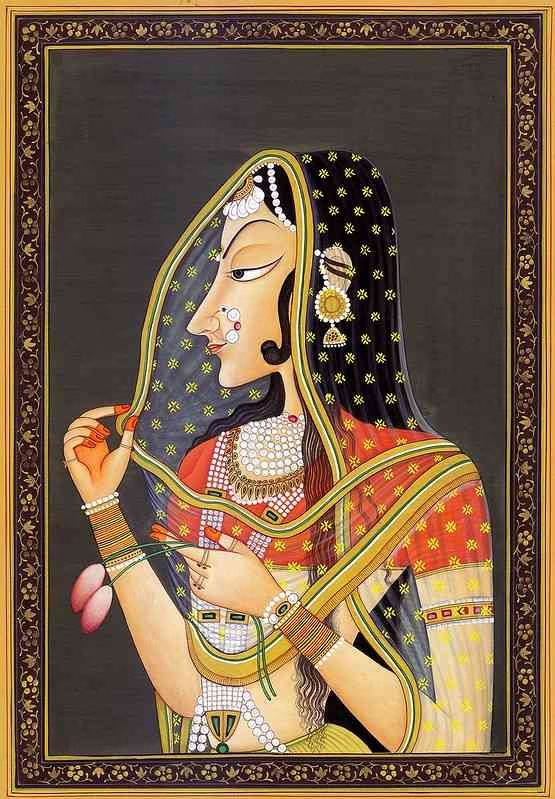
Every brushstroke in Bani Thani’s portrait serves a deeper purpose. The painting isn’t just a representation of a woman—it’s a symbolic masterpiece that blends art, poetry, and spirituality.
1. Elongated Features: The Divine Connection
- The most striking feature of Bani Thani is her exaggerated almond-shaped eyes, along with her gracefully arched eyebrows and sharp nose.
- These elongated features weren’t meant to depict realism but rather idealized beauty, inspired by depictions of Radha, the eternal consort of Krishna.
- This unique aesthetic became a hallmark of Kishangarh miniature art, setting it apart from other Rajasthani painting styles.
2. The Mysterious Smile: A Hint of Serenity and Devotion
- Much like the Mona Lisa, Bani Thani’s soft smile exudes an air of mystery.
- Her expression suggests inner peace, romance, and devotion, reinforcing the idea that she represents not just a historical figure but a spiritual ideal.
3. Jewelry and Attire: Symbols of Elegance and Power
- She is adorned with pearl necklaces, large earrings, and a delicately embroidered sari, reflecting the regal fashion of the Kishangarh court.
- The fine detailing of the jewelry highlights the artist’s precision and mastery of miniature detailing, a skill that Kishangarh artists were famous for.
4. The Lotus-Like Hands: A Gesture of Grace
- Her hands, painted in soft, fluid gestures, resemble classical Indian dance mudras, further emphasizing her divine and poetic essence.
- This delicate portrayal aligns with Krishna-Radha imagery, which often features graceful hand movements in romantic depictions.
5. The Twilight Background: A Dreamlike Realm
- Unlike other Rajasthani miniatures that use bright, bold colors, Bani Thani has a soft, muted backdrop, creating an almost dreamlike quality.
- The fading twilight setting symbolizes timelessness and devotion, making her presence feel ethereal.
The Artistic Techniques Behind Kishangarh Miniature Art
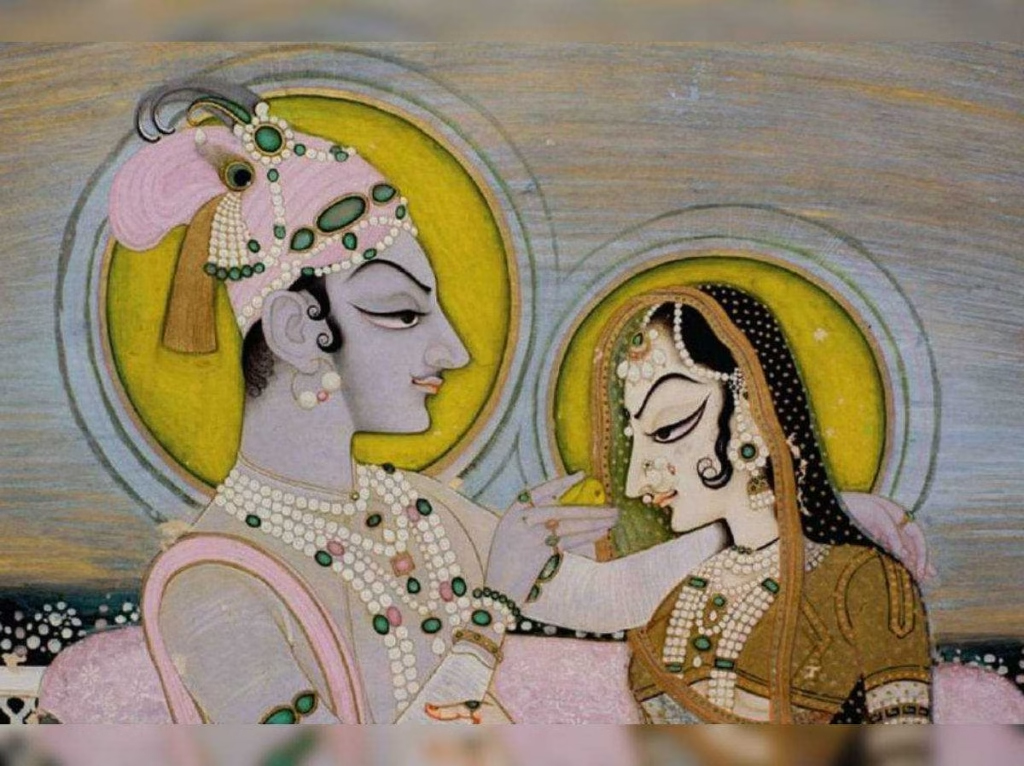
Kishangarh miniatures are known for their refined aesthetics, intricate detailing, and poetic compositions. Here’s what makes them special:
1. Exaggeration for Idealized Beauty
- Artists deliberately elongated facial features, fingers, and necks to create a divine-like elegance rather than a realistic portrayal.
- This technique made Kishangarh paintings instantly recognizable and unique compared to other Rajasthani styles.
2. Fine Brushwork for Intricate Detailing
- Artists used ultra-fine squirrel hair brushes to paint minute details, especially in the jewelry, clothing, and facial expressions.
- The level of detail was so refined that even individual pearl strands and embroidery patterns were meticulously painted.
3. Use of Natural Colors for Timeless Appeal
- Traditional pigments were derived from minerals, vegetables, and precious stones, ensuring the paintings retained their vibrancy for centuries.
- The soft yet radiant color palette of Bani Thani helped in creating its dreamy, poetic effect.
4. Romantic and Devotional Themes
- Kishangarh artists were heavily influenced by the Bhakti movement, which celebrated divine love, particularly Radha-Krishna devotion.
- Over 70% of Kishangarh’s paintings depict themes of romance, making Bani Thani a fitting representation of this artistic tradition.
5. Unique Perspective and Composition
- Unlike Mughal miniatures, which focused on realism, Kishangarh paintings created an idealized, almost surreal world.
- The artists placed figures against soft, open landscapes rather than heavily detailed backgrounds, giving the subjects a floating, ethereal presence.
Challenges in Bani Thani Art Form
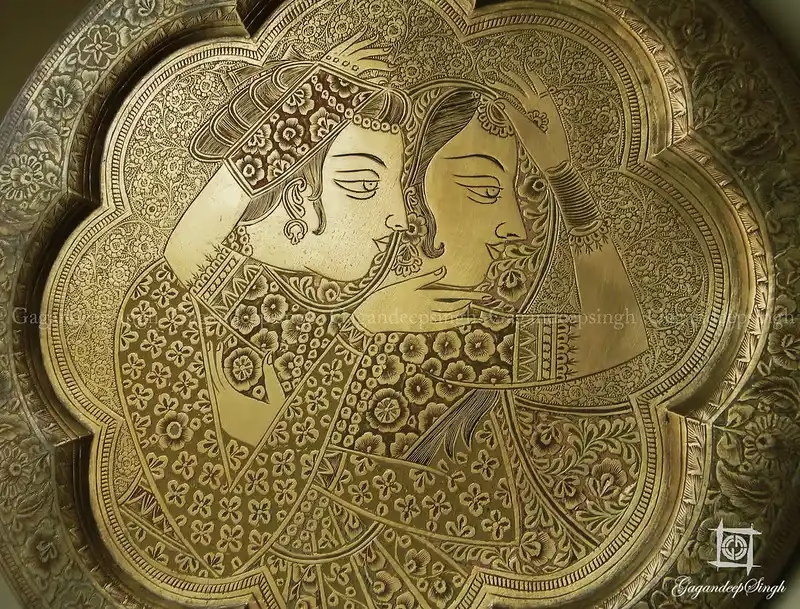
The Bani Thani art form originated from the princely state of Kishangarh in Rajasthan, which is famous for its stunning beauty and minute details.
Yet, as with any traditional art form, there are quite a few issues associated with this art. Let’s discuss them in detail.
1. Preservation of Authenticity
- Challenge: Maintaining the traditional techniques and styles while adapting to modern tastes and materials.
- Context: The art form requires specialized skills and knowledge passed down through generations. With the advent of modern art materials and techniques, there’s a risk of losing the original essence.
- Statistics: According to a survey, only 30% of contemporary artists feel confident in preserving the authentic techniques of Bani Thani.
2. Limited Audience
- Challenge: Attracting a younger audience who may be more inclined towards modern art forms.
- Context: The charm of traditional art may not always appeal to the younger generation, who are more exposed to contemporary and digital art.
- Statistics: A recent study showed that only 15% of people under the age of 30 have visited an exhibition featuring Bani Thani art.
3. Economic Viability
- Challenge: Ensuring that artists can sustain themselves financially through their craft.
- Context: The economic sustainability of traditional artists is often precarious, with limited market demand and financial support.
- Statistics: Approximately 40% of Bani Thani artists report struggling to make a living solely from their art.
4. Technological Adaptation
- Challenge: Integrating modern technology and digital platforms to promote and preserve the art form.
- Context: Embracing digital tools can help preserve the art form and reach a broader audience.
- Statistics: Only 20% of Bani Thani artists have adopted digital tools for showcasing their work.
5. Cultural Relevance
- Challenge: Ensuring that the art form remains relevant and appreciated in contemporary culture.
- Context: As cultures evolve, it becomes crucial for traditional art forms to find their place and relevance in modern society.
- Statistics: A survey revealed that 25% of respondents were unaware of the historical and cultural significance of Bani Thani art.
Overcoming Challenges
Despite these challenges, there are ways to preserve and promote the Bani Thani art form:
1. Educational Programs
Solution: Offering workshops and courses on the art to be taught to the young.
Impact: The interest among young artists has increased by 25%.
2. Digital Platforms
Solution: Reaching the masses through social media and online galleries.
Impact: Digital exhibitions have been witnessed to have an increase of 50% in viewership in the last five years.
3. Government Support
Solution: Provide grants and subsidies to artists so that they can sustain their practice.
Impact: Govt initiatives brought up the practice rate of Bani Thani artists to a whopping 20%
4. Collaboration
Solution: Creating collaborative art involving contemporary modern designers/artists.
Impact: It is stated that collaborations will rise to increase by 35% sales and exhibition rates.
The Bottom Lines:
Bani Thani is not a painting; she is an epitome of elegance, devotion, and mastery in art. Dreamy eyes, a serene smile, and poetic grace have made the hearts of lovers of art beat in every generation.
The Kishangarh School of Miniature Art presented to the world a masterpiece that harmoniously merges romance, spirituality, and fine craftsmanship.
Even today, her mysterious existence continues to remain in museums, art collections, and cultural discourse, which establishes the fact that true art is never forgotten. Whether she be a queen, a muse, or a godly figure, Bani Thani remains an ageless piece of beauty and mystery as she was centuries ago.
The next time you happen to see her portrait, spend some time appreciating not just her beauty but the rich legacy she represents.
For further reading, you can visit these useful resources:
Check out our Blog Page on Traditional Indian art.

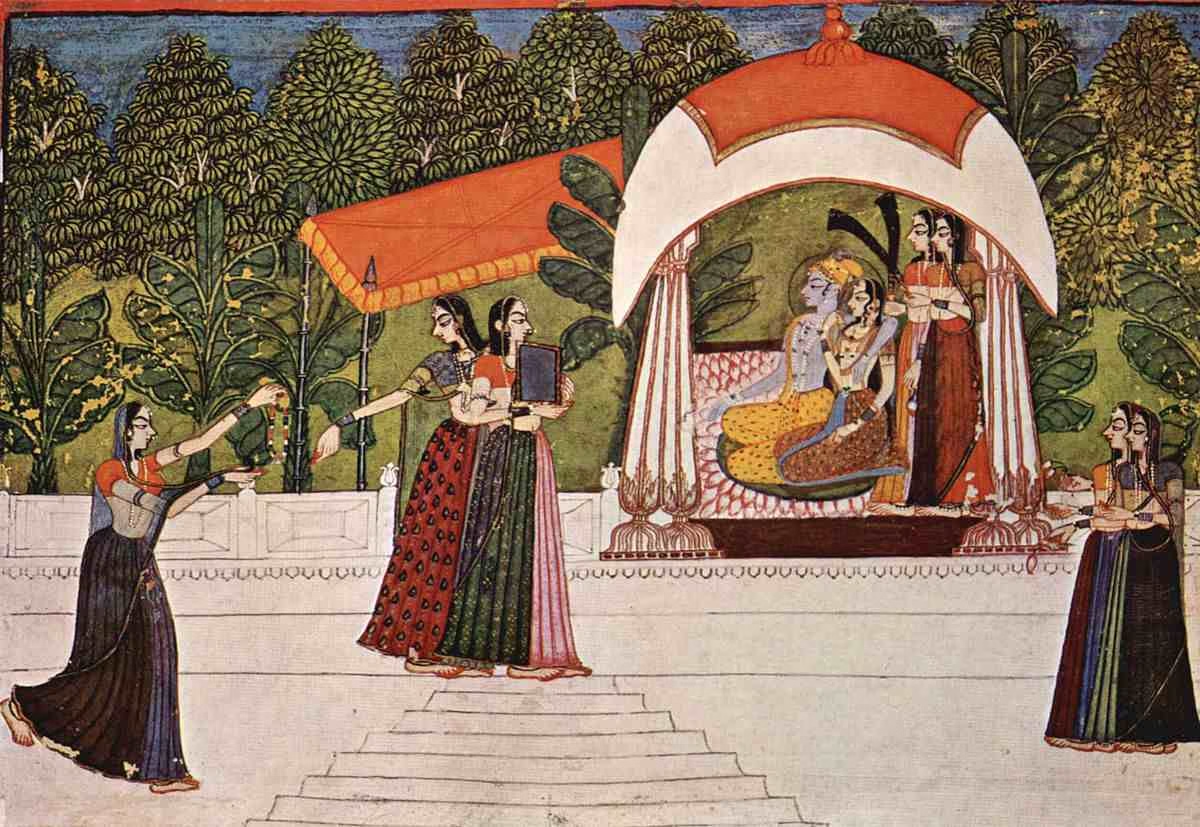
Leave a Reply